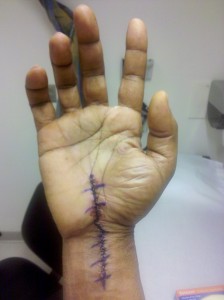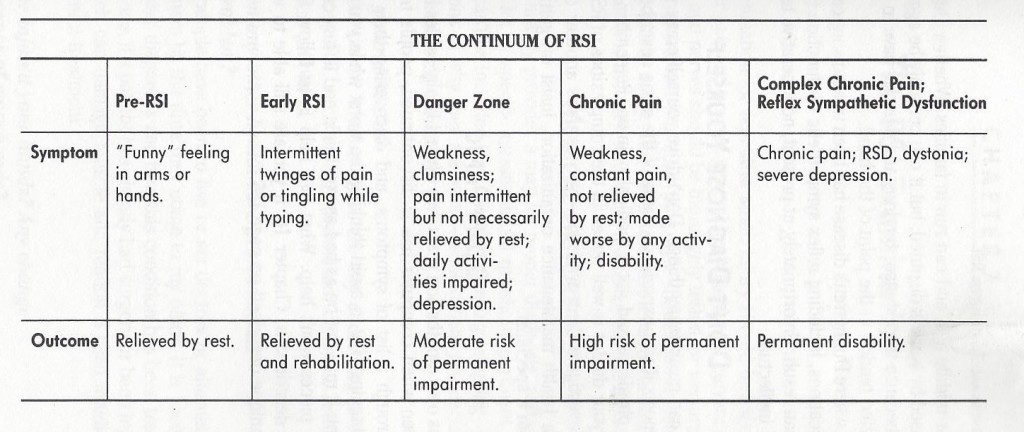 Repetitive strain injury (RSI) continues to be a malody which afflicts many persons who do certain fine-motor-muscle tasks (typing, playing musical instruments, chopping food, assembling parts on a manufacturing line, etc.) repetitively over a long period of time. The results (in certain persons) can be inflammation of tendons, pain, numbness, tingling, weakness and inability to function with that particular lamb (finger, wrist, arm, etc.). Afflictions which fall in the umbrella of RSI include carpal tunnel syndrome, cubital tunnel syndrome, thoracic outlet syndrome, tendinitis and others. RSI may also be referred to as cumulative trauma disorder (CTD).
Repetitive strain injury (RSI) continues to be a malody which afflicts many persons who do certain fine-motor-muscle tasks (typing, playing musical instruments, chopping food, assembling parts on a manufacturing line, etc.) repetitively over a long period of time. The results (in certain persons) can be inflammation of tendons, pain, numbness, tingling, weakness and inability to function with that particular lamb (finger, wrist, arm, etc.). Afflictions which fall in the umbrella of RSI include carpal tunnel syndrome, cubital tunnel syndrome, thoracic outlet syndrome, tendinitis and others. RSI may also be referred to as cumulative trauma disorder (CTD).
Some statistics point to RSI as being the most costly injury faced by industry. For example, I was in a recent presentation by a voice-recognition software manufacturer, in which they indicated that Intel (one of their customers) has actually deployed software throughout its firm which monitors the number of keystrokes which each employee types. Once the employee has exceeded a certain threshold of keystrokes for that time period, the employee is required to go home for the rest of the week. I was unable to verify this fact, but it sounds plausible.
RSI is more easily prevented than cured. Accordingly, here are some resources to give you more information on the topic.
- Repetitive Strain Injury: A Computer User’s Guide (by Emil Pascarelli; One of the most widely referenced books on the topic for the last 20 years)
- http://rsi.unl.edu/
- http://www.rsi.deas.harvard.edu/what_is.html
- http://www.eecs.umich.edu/~cscott/rsi.html
- http://howto.wired.com/wiki/Prevent_RSI
- carpal tunnel syndrome (Mayo Clinic)
- carpal tunnel release surgery
- Typical recovery and prognosis for improvement after carpal tunnel release surgery is described here
- Dragon NaturallySpeaking (speech recognition):
http://www.nuance.com/dragon/index.htm
“The Continuum of RSI” table from Dr. Emil Pascarelli’s book
Additional information for MUSICIANS
- A Painful Melody – Prevention & Treatment of Musicians’ Injuries
“How quickly you recover from injury is directly related to how long you continued to play through pain or discomfort. In cases of severe injury, complete recovery is not possible. However, if you are proactive, acknowledge that something is wrong, and come up with a plan to correct things before you are severely injured, your recovery will be much quicker and less likely to require drastic measures.1 If an injury has continued for several months, further complications can arise such as adhesions (layers of body tissues grow together due to chronic inflammation or microtrauma), scar tissue from cumulative trauma, and atrophy of muscles no longer used.1 The steps below outline recovery from a severe injury.” - MusiciansHealth.com
- Musicians and Injuries
“PAY ATTENTION TO YOUR BODY. Pain is your body yelling that it’s in big trouble, but learning what is comfortable or awkward for your body before you’re in pain may prevent injury.”
